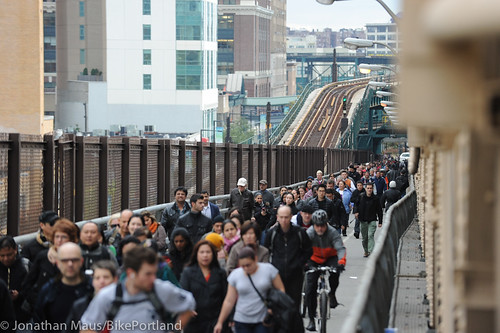
(Photos © J. Maus/BikePortland)
made possible by:
- Planet Bike
- Lancaster Engineering
- Readers like you!
Mass transit is a way of life here in New York City. The subway is the artery that allows the city to survive at its famous pace. But with significant water damage from Superstorm Sandy, the New York City subway is still not running. Buses are back, but with limited routes.
With people getting back to normal following the one-day hurricane holiday on Tuesday, that meant today was a work day. And without the subway; that meant many New Yorkers used their feet to get there. While streets were jam packed with cars, taxis and buses — most of them going nowhere fast — the bike paths and sidewalks were inundated with flowing human traffic.
I rolled over to the Queensboro Bridge to see how it played out. It was fascinating to see so much human powered commuting in action. It was so jaw-dropping, it became an event in and of itself. Even locals stopped to take photos of the scene.
The protected bike lanes are the new subway…
On the Manhattan side of the bridge, I met an Italian couple. I noticed them with their bikes parked, looking at maps, so I struck up a conversation. Graziano di Paola and Valentina Manacorda are from Rome and they’re celebrating their honeymoon. They got here last week before the storm hit. They didn’t let Sandy crimp their sightseeing plans. “We didn’t plan to bike; but without the subway, we rented them from a bike shop in Brooklyn. There’s no other way to get around!” said Valentina. They were in great spirits and even asked me to take their photo in front of the chaos.
——
Ciao from New York City. At this point, my flight is scheduled for Saturday afternoon (I hope third time is a charm).
— This post is part of my ongoing New York City coverage. I’m here for a week to cover the NACTO Designing Cities conference and the city’s bike culture in general. This special reporting trip was made possible by Planet Bike, Lancaster Engineering, and by readers like you. Thank you! You can find all my New York City coverage here.


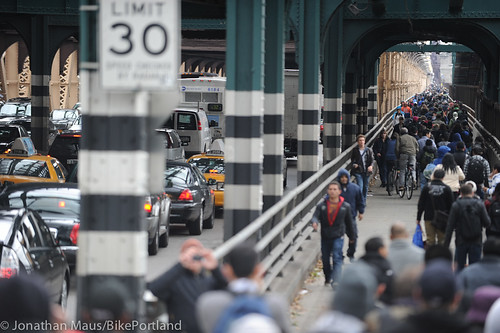
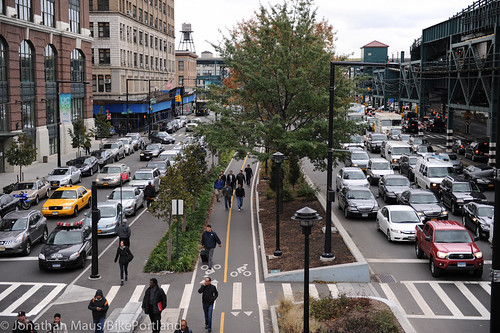
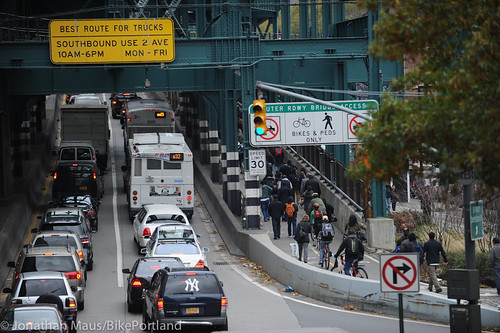

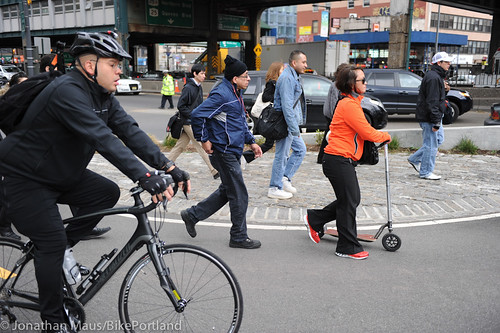

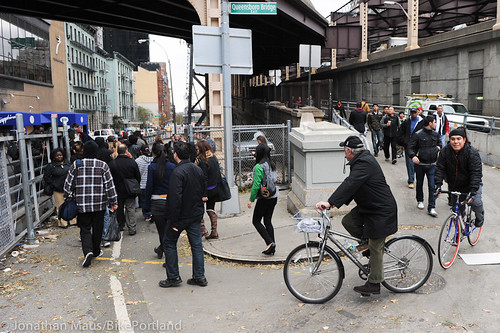
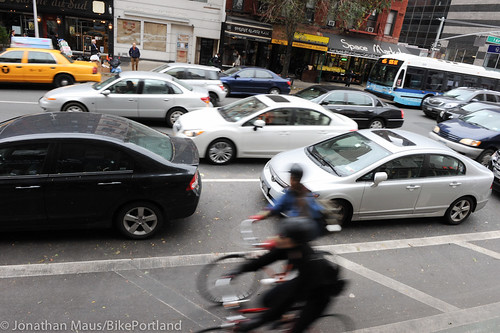
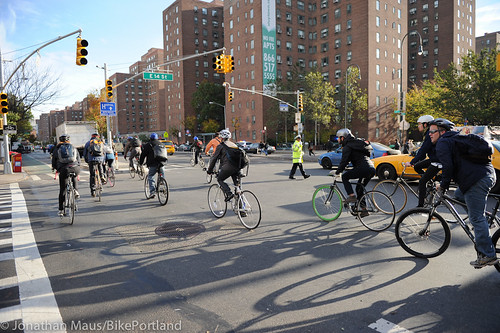
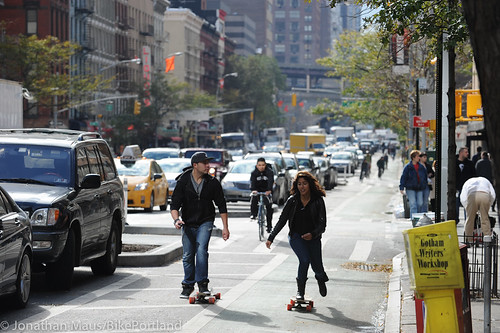
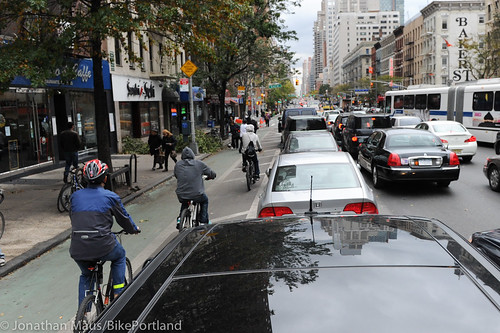
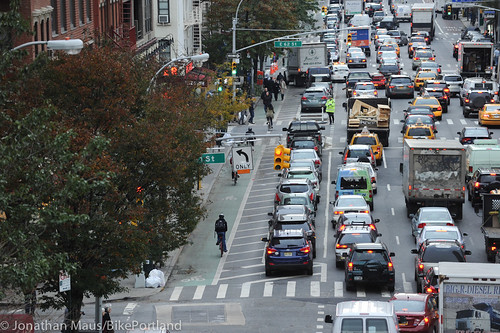
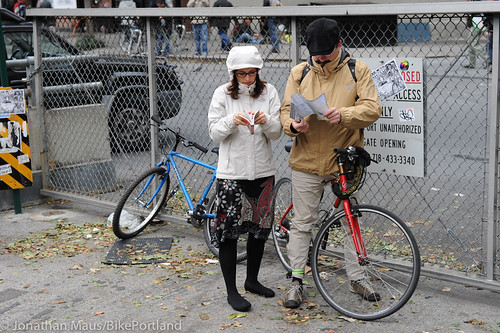
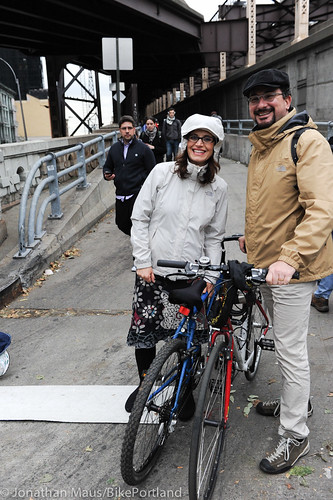

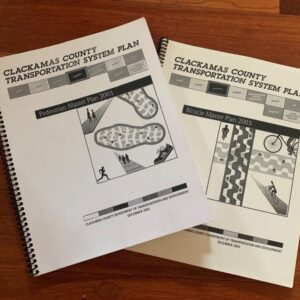
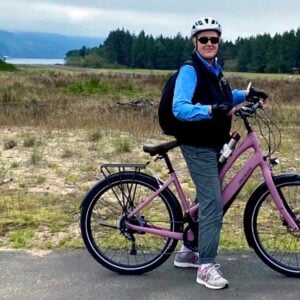
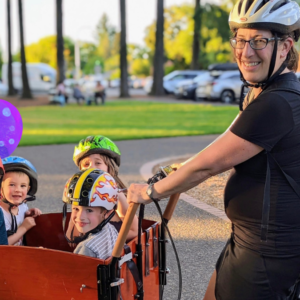
Thanks for reading.
BikePortland has served this community with independent community journalism since 2005. We rely on subscriptions from readers like you to survive. Your financial support is vital in keeping this valuable resource alive and well.
Please subscribe today to strengthen and expand our work.
That is awesome! Terrible what has happen, but maybe this gives people a new perspective and they will continue walking/biking after the power/trains come back.
Thanks Jonathan for all the coverage from NYC, both pre- and post-Sandy.
Your coverage of both the conference and this aftermath of the storm has been inspiring. Thank you.
The future is human-powered.
Looks more like walking rules and biking is basically impossible to me.
The pictures do seem to show overwhelmingly more people walking than biking. Maybe they’re subway riders who’ve not had a need for a bike. If something were to happen the subways aren’t able to be up and running for a lengthy period of time, perhaps some of those people will decide to get a bike to ride.
News stories have said some of the flooded subway tunnel’s electric components could take a long time to get dried out, checked out, possibly requiring replacement before the system can be back in operation.
Most of these photos are on the approach and exit of the Queensborough Bridge which is a huge choke point. It’s probably more than a 1/4 mile to cross. Away from the choke points the bikes are going to be covering a lot of ground way faster than the walkers.
I just biked over tonight around 8:30pm, and the traffic was lighter than what is shown in the photos. However, I can assure you that the traffic was consistent across the entire bridge, which is about 1.5 miles. It took a good bit longer to bike across than usual, due to the heavy pedestrian traffic, but most walkers stuck to one side.
Thanks for the actual length. I think I didn’t say what I meant clearly. Getting to the bridge approaches and after crossing in Manhattan cyclists would have a lot more room to ride. The entire bridge and approaches is the choke point.
For example were i in NYC at my sister’s I would have had a 5 mile ride to Queens Plaza from Rego Park and most of that would have been fairly clear riding. Certainly not in that crowd and once across I’d have had another 3 miles of riding to get to the Museum of Natural History so biking would have still been a much better option than walking.
what I love about this is seeing all modes of transport getting along.
I can’t believe we get this kind of coverage from the eye of the storm. Seriously awesome stories this week and last!
My college friend lives in Brooklyn and posted the following on Facebook:
“Not sure which is more awesome: the bicycle-powered phone-charging stations set up by Times Up in the East Village, or the bicycle-powered pumps they’re using to pump out basements.”
Can anyone in NYC take pictures to verify this?
I can with the first part, at least: http://urbanvelo.org/introducing-the-tools-of-the-apocalypse/
This is all so great Jonathan! Perhaps its time to bring the DRT to New York.
seems you covered more than any nyc bicycle bloggers on post-Sandy storm. good work…
It would be a shame if the bridges fell down and they all turned into zombies.
What do you mean “turned” in to zombies?
Okay in all seriousness: what is the thought process of masses lock in automotive traffic : bovine herd or oblivious superiority?
Either way stuck in gridlock with life flowing around them they must be brain dead zombies to insist that their way is still best.
Awesome stories Jonathan. I loved having a bike perspective of this situation. One thing that strikes me even more true because of your coverage: when any trouble strikes (weather, earthquake, etc) those of us that have made biking a normal part of our life are at a huge advantage to go about our own lives and lend a hand to those that need help. I know if there was a massive storm in Portland that shut down public transport, flooded sections of town, knocked over trees, power lines, etc. I would still be able to navigate on my longtail and go where I needed to go. Looks like NYC bikers are having that experience. Maybe a few more folks out there will realize it is possible to make a mode shift. Thanks for the great reporting and images.
great coverage but this just shows how use of our 2 or 4 wheel human powered vehicle is far more reliable than any transit system where i live in metro vancouver on the skytrain bikes are not permitted during the rush anyways but are on a regular bus allowed but i find most times unles the distance is over 25 miles i can ride there faster anyways but get to enjoy the scenery alot better and not sitting beside someone who forgot too bath lol
There was a story about the NYC gridlock on OPB this morning, with an interview with a motorist who was complaining it took him two hours to go 2.5 miles. I couldn’t help but think if he was on a bike, he could have done that 10-15 minutes.
Even without a bike, he could walk that far in under an hour.
Yeah, I understand maybe if you’re coming in from 10-15 miles out of town maybe the whole trip isn’t walkable, but perhaps parking somewhere and walking INTO Manhattan would be better than just sitting in gridlock like a dope.
Those photos almost look like the west side trail any sunny afternoon. Basically, on a bike you’re constantly dodging. But still enjoy seeing so many people out and about. At least the storm hit before it got seriously cold out. People look like may they are enjoying their walk.
Why have I not heard the word “bike” on the NPR morning news?
Great job Jonathan, both conference and storm. Journalism at its best.
The good news is walking is not only a viable mode of transportation in NYC, but to a certain extent far more than we’ve seen in the last half century, a viable mode in many cities and towns across the USA.
Italians always are fully functional in chaos.
Veni Vidi Cycli!
🙂
And very well dressed.
This situation makes me think that we (the bike proselytizing community) have been going about this all wrong.
When disasters occur, and climate science tells us this will happen more frequently and with more intensity, our infrastructure will fail.
Any city is layer upon layer of services; like water, phone, public transit, police; that are dependent upon foundational systems like electricity and liquid fuels.
What we as city dwellers need is an urban disaster preparedness tool that facilitates near equivalent personal mobility without being reliant upon failed infrastructure.
Something high tech like a bicycle.
I know many people see bikes as toys, racing equipment, a mobile exercise machine or at best a mundane form of daily mobility.
I propose that in addition to disaster kits containing sufficient food, water and other critical daily supplies that any real disaster prep kit contain at least on bike for every angle bodied person. Cargo bikes would be a nice addition but in terms of surviving “The Day After” the simple ability to GET OUT and towards help is likely to be the most critical.
Bikes: the lynch pin to personal survival when the fit hits the shan.
I’ve been thinking the same too. A number of years ago when Vancouver got a surprise snow storm and shut down the buses and roads, we just jumped on our knobby tired mountain bikes and got around fine.
I’m a bit surprised that private motorists are allowed to enter Manhattan on the bridges. With tunnels out, and subways flooded as well, the bridges need to be open to allow food and other needed supplies to be brought in and people needing emergency treatment to be brought out. The bridges simply don’t have the carrying capacity to handle private cars along with everything else. The fact that private cars have not been banned from entering Manhattan indicates the severity of the car addiction, even in NYC.
If cars were banned from the bridges bicycles could travel in one of the motorists’ lanes and pedestrians could continue to use the bike lanes. As it is, the peds use the bike lanes and the cyclists–from what I can see–have to walk as well. Not tragic, but it indicates where bikes currently stand in the ped/bike/car triad.
“…If cars were banned from the bridges bicycles could travel in one of the motorists’ lanes and pedestrians could continue to use the bike lanes. …” Al from PA
Haven’t checked NYC’s vehicle code, but it might be worth it to see exactly what laws there say about people on bikes right to use the main lanes of the road. The great number of people on foot being circumstances that could impede or make bike travel on bike lanes unsafe, the law might allow bike traffic use of the main lanes.
Of course, boggled up as NYC-Manhattan’s vehicle traffic probably still is, walking may be faster than driving or biking.
Cuba Survived the Oil embargo by importing 2 million bicycles.
Humans as a species are masters at adapting, with one glaring flaw.
The inability to recognize the difference between easier & better.
Funny that you mention the oil embargo:
NPR is reporting on 2012 11 01 that not only are the streets backed up beyond imagination…
BUT…
that the gas stations pump gas and diesel with electricity that most stations no longer have.
This is compounded by the fact that bulk deliveries of fuel to stations have been delayed, canceled or logistically impossible.
I truly have sympathy for the people living through this (in high school we had a 2 week break after Hurricane Hugo (force 5) left most of simply clearing roads for the first few days before the power company could even find us). This situation will truly show the disadvantages of auto centric transport and the advantages of human powered travel.
Great job. A perspective that I haven’t seen anywhere else.
Don’t take this the wrong way, but I hope you miss your flight again. I want to see more coverage from NYC as things start to recover.
Ditto, Ladyfleur. Jonathan, you are in the center of a great story and you are doing an excellent job reporting it. Consider staying longer to keep us informed. Do we need to chip in to keep the great pics coming?
Al from PA, I think I heard that private automobiles weren’t being allowed into Manhattan unless they had at least 3 occupants. So the private cars on the street either (1) were already in Manhattan, (2) had already dropped off their other occupants, or (3) got in due to lack of enforcement.
EIther way, I sure wouldn’t think of driving in Manhattan on a normal day, let alone this week. Even under normal conditions it’s a staple of movies and TV for people to get out of a cab in NYC and start walking because it’s faster.
Would be great to know the weight loss and money saved for this day in NYC.
Take a good long look Portland, a Cascadia Quake will create many of the same issues.
Thank you for the great report and fabulous pictures. Hoping for a speedy recovery for all.
Has Bloomberg encouraged citizens to use bicycles to move around in the city? It seems like it might be worth it considering the vehicular gridlock.
Jonathan, thanks for being our “personal” reporter in NYC and showing the bike perspective!
I was wondering how the bike share will help in situations like this. It hasn’t started in NYC yet, but it would be a great way to get people on bikes in emergencies who don’t usually own bikes. That is, of course, unless the bikes are locked electronically and rely on electricity…
Pictures of NYC volunteers draining basements with bicycle-powered pumps:
http://www.cyclelicio.us/2012/nyc-drain-flooded-basement-bicycle/
Love it!
“Take a good long look Portland, a Cascadia Quake will create many of the same issues.” – Ethan
Including this (reported by GMA): “Police have been keeping order at hours-long gas station lines, but the fight for fuel is starting to get nasty.”
Not having utilities at home is obviously the worst problem for millions, but fuel shortages are also becoming a major problem for millions of people who are totally car-dependent. Most of Oregon’s gasoline comes down from Puget Sound refineries via a big pipeline that will be out of service for a loooong time. I’d bet our shortages would last even longer than those in New Jersey.
It’s good that so many of us in Portland are able to be car-independent if needed. This not only includes the totally car-free, but probably several times that many who enjoy the convenience of a car in normal circumstances but COULD get around by foot and bike if needed. My car will certainly stay parked in the event of a major disaster like the predicted offshore quake.
After seeing the situation in NYC, though, a vehicle might be handy for charging up cellphones! Non-car-owners who want this ability could get one of those $40 car battery booster things that you charge in your home and are intended used to jumpstart a car. Most of these also have a cigarette lighter port that can be used to power 12V devices including phone chargers, and would probably provide enough juice for days of phone charging.
Besides the tradition of checking your smoke alarm batteries, the upcoming time-change weekend is an excellent time to review disaster plans, beef up disaster kits and replenish emergency food and water supplies. Sandy provides a fresh view of how a natural disaster plays out in an urban area, as well as a fresh reminder to be prepared. I know what I’m doing this weekend.